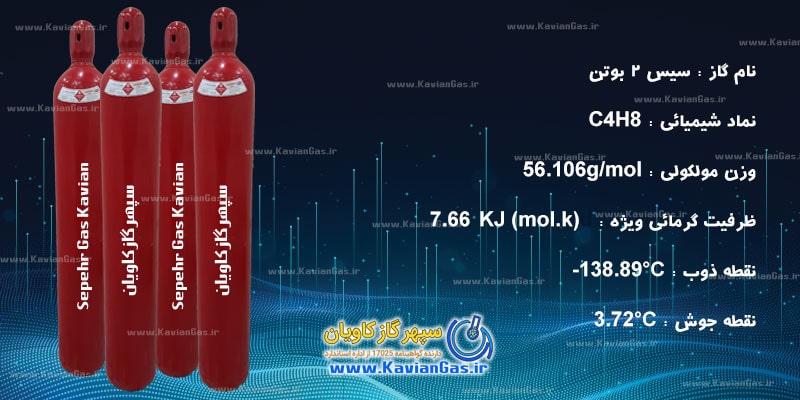گاز ترنس 2 بوتن C4H8 Gas
فروش گاز ترنس 2-بوتن | trans-2-Butene Gas | trans-Butene 2 | trans-2-Butene | 2-trans-Butene | (E)-2-butene | trans-1,2-Dimethylethylene | H3C-CH=CH-CH3
کاربرد ترنس 2-بوتن
در تولید لاستیک بوتیل از ترنس 2-بوتن استفاده میکنیم.
ازترنس 2-بوتن به عنوان خوراک برای تولید پروپیلن با قلب و تحریف و یا برای تولید octenes و مخلوط های بوتن-2 دیمر استفاده میکنیم .
مشخصات فیزیکی و شیمیایی ترنس 2-بوتن
| وزن مولکولی |
56.106g/mol |
فاز جامد |
|
| نقطه ذوب | 105.53 منفی درجه سانتی گراد |
| گرمای نهان ذوب |
173.913kj/kg |
فاز مایع |
|
| چگالی مایع |
626.45nkg/m3 |
| نقطه جوش |
(1.013 bar) : 3.72 °C |
| گرمای نهان تبخیر نقطه |
(1.013 bar at boiling point) : 405.19 kJ/kg |
فاز گازی |
|
| چگالی گاز |
(1.013 bar at boiling point) : 2.6056 kg/m3 |
| چگالی گاز |
(1.013 bar and 15 °C (59 °F)) : 2.4587 kg/m3 |
| ضریب تراکم |
(Z) (1.013 bar and 15 °C (59 °F)) : 0.96510.96503 |
| وزن مخصوص |
1.93 |
| حجم شخص |
(1.013 bar and 25 °C (77 °F)) : 0.4228 m3/kg |
| ظرفیت گرمایی در فشار ثابت |
(Cp) (1.013 bar and 25 °C (77 °F)) : 0.0904 kJ/(mol.K) |
| ظرفیت گرمایی درحجم ثابت |
(Cv) (1.013 bar and 25 °C (77 °F)) : 0.0806 kJ/(mol.K) |
| نسبت گرمایی ویژه |
(Gamma:Cp/Cv) (1.013 bar and 25 °C (77 °F)) : 1.1209 |
| ویسکوزینه |
(1.013 bar and 25 °C (77 °F)) : 8.028E-05 Poise |
| رسانایی گرمایی |
(1.013 bar and 25 °C (77 °F)) : 17.106 mW/(m.K) |
برگه های اطلاعات ایمنی (SDS) شامل اطلاعات در مورد مواد تشکیل دهنده محصول، خواص فیزیکی و شیمیایی، اثرات بالقوه بر روی سم شناسی و محیط زیست، شناسایی خطرات، دست زدن و دستورالعمل ذخیره سازی، و همچنین توصیه حفاظت پرسنل و اطلاعات مربوط به نیاز حمل و نقل، کمک های اولیه و هدایت را عنوان می کند .
خطرات عمده :
گاز ترنس 2-بوتن آتش زا است .
گاز ترنس 2-بوتن سمی نیست و بوی آن کمی معطر می باشد.
کلاس DOT خطر (USA): گاز قابل اشتعال
Butene is an organic chemical compound, linear alpha-olefin (alkene),and one of the isomers of butene. The formula is CH3CH2CH=CH2. It is a highly flammable, easily condensed gas.
Reactions
1-Butene is stable in itself but polymerizes readily to polybutene. Its main application is as a comonomer in the production of certain kinds of polyethylene, such as linear low-density polyethylene (LLDPE). It has also been used as a precursor to polypropylene resins, butylene oxide, andbutanone.
Manufacturing
1-Butene is produced either by separation from crude C4 refinery streams or from the dimerization of ethylene. It is distilled to give a very high-purity product. An estimated 12 billion kilograms were produced in 2011, usually as a mixture with isomeric butenes.
Butene, also known as butylene, is an alkene with the formula C4H8. It is a colourless gas that is present in crude oil as a minor constituent in quantities that are too small for viable extraction. It is therefore obtained by catalytic cracking of long chain hydrocarbons left during refining of crude oil. Cracking produces a mixture of products, and the butene is extracted from this by fractional distillation.
Butene can be used as the monomer for polybutene but this polymer is more expensive than alternatives with shorter carbon chains such as polypropylene. Polybutene is therefore commonly used as a co-polymer (mixed with another polymer, either during or after reaction), such as in hot-melt adhesives.
Isomers
Among the molecules which have the chemical formula C4H8 four isomers are alkenes. All four of these hydrocarbons have four carbon atoms and one double bond in their molecules, but have different chemical structures. The IUPAC and common names, respectively, of these chemical compounds are:

In the chemical structures above, the small blue numbers in the structure images are the numbering of the atoms in the main backbone chain of the molecules. Other organic compounds have the formula C4H8, namely cyclobutane andmethylcyclopropane, but are not alkenes and are not discussed here. There are also cyclic alkenes with four carbon atoms overall such as cyclobutene and two isomers of methylcyclopropene, but they do not have the formula C4H8 and are not discussed here.
All four of these isomers are gases at room temperature and pressure, but can be liquefied by lowering the temperature or raising the pressure on them, in a manner similar to pressurised butane. These gases are colourless, but do have distinct odours, and are highly flammable. Although not naturally present in petroleum in high percentages, they can be produced from petrochemicals or by catalytic cracking of petroleum. Although they are stable compounds, the carbon-carbon double bonds make them more reactive than similar alkanes, which are more inert compounds in various ways.
Because of the double bonds, these 4-carbon alkenes can act as monomers in the formation of polymers, as well as having other uses as petrochemical intermediates. They are used in the production of synthetic rubber. But-1-ene is a linear or normal alpha-olefin and isobutylene is a branched alpha-olefin. In a rather low percentage, but-1-ene is used as one of the comonomers, along with other alpha-olefins, in the production of high density polyethylene and linear low density polyethylene. Butyl rubber is made by cationic polymerisation of isobutylene with about 2 – 7% isoprene. Isobutylene is also used for the production of methyl tert-butyl ether (MTBE) and isooctane, both of which improve the combustion of gasoline.


بدون دیدگاه